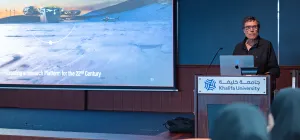Smooth Operators

As we mentioned in our previous news, the first scientists have finally arrived at the station. Thanks to our professional team at PEA, everything has gone well and the scientists have now headed out into the field to start their research.
In addition to preparing the Perseus Airstrip for the plane carrying the scientists from Cape Town, the BELARE team prepared the living containers and mobile power units that the scientists from MASS2ANT and the CLIMB projects have been using on their journey to the coast. While the CLIMB project team has already returned to PEA, the MASS2ANT team has started their weeks-long field research at the coast.
Keeping up the Princess
A lot of work goes into preparing the station for the arrival of the scientists and to keep it running as maximum efficiency.
One of the first things the team needs to do each season is to adjust the levels of the north and south annexes of the station, which sit on a slowly moving glacier. The hinge system the team installed a few seasons ago for the two annexes to rest upon make it easy to make adjustments. This needs to be done twice a year - once when the opening team arrives at the beginning of the season, and once again before the last members of the team close the station down for the winter. Glaciers move faster than you think (about 9 cm per year in that location)!
And of course the renewable energy systems need to be maintained. After enduring a punishing austral winter, the Princess Elisabeth Antarctica always needs to undergo routine maintenance to help keep it working properly as a comfortable and eco-friendly research station.
Guus Luppens, Johan Demuylder, and Paul Herman have been busy changing a few solar panels that were damaged during the winter with the latest generation double sided panels. The team also checked and maintained all nine of the wind turbines installed on Utsteinen Ridge that provide the station with wind power. After surviving strong winds all winter, they are working perfectly. The station is producing a lot of renewable energy from the sun and the wind. These two sources of energy are complementary and can supply the station each on their own when conditions are optimal for one or the other. When the sun and the wind work together, the station produces more energy than it needs to function. This surplus is used to heat up workshops and garages, and allows the engineers to consider new types of energy storage and new types of energy sources for eco-friendly vehicles and technologies that are currently under development.
The entire electrical system for the south annex - which the team has been building over the least two seasons and which holds new additional living quarters, the station’s snow melter, storage areas, and the new surgery room - has now been completed. The team installed a new building control system, which is usually used in large facilities such as hospitals, airports, etc. It allows flexible electrical control of the building.
The renewable energy that the station and the team uses is controlled and managed by a Programmable Logic Controller (PLC) circuit. The PLC is the brain of the station that manages all electricity production at the station and prioritises its use depending on a predefined hierarchy of user priorities. However, after 12 years of service, it was time for a hardware upgrade to the latest available technologies. Station engineers Wouter Paesen, Nicolas Herinckx, and Wouter Verscheure have been installing the new hardware, provided by station partner Schneider Electric. Energy management at the station will become even more reliable thanks to these latest upgrades!
The Princess gets a zero-emission friend
With all of this well-managed renewable energy produced, it’s possible to use that extra energy to heat up the non-residential areas of the station like the garage - or to charge vehicles, such as the new addition to the station’s fleet of vehicles, the Venturi Antarctica, the world’s first electric polar exploration vehicle. A team from Venturi - a Monegasque company that produces high-performance electric vehicles - arrived on the same flight as the scientists with the new vehicle to field test it in Antarctica.
Since December 10th, the Venturi team has been testing the amazing new addition to PEA’s fleet of vehicles. Able to carry up to six people and equipment, and function in temperatures as low as -50°C, the electric vehicle can travel up to 60 km on a single charge, and can even carry an extra battery to extend this range.
The scientists at the station are already taking advantage of the new vehicle. The Venturi Antarctica has supported field training exercises for scientists as well as a field expedition for the CLIMB project as they went to the Antarctic Plateau to collect samples from their atmospheric particle sampling units.
Now is the time to focus on the development of new technologies to enable us to further reduce the carbon footprint of conducting research in the polar regions and everywhere else on Earth!
Download





















